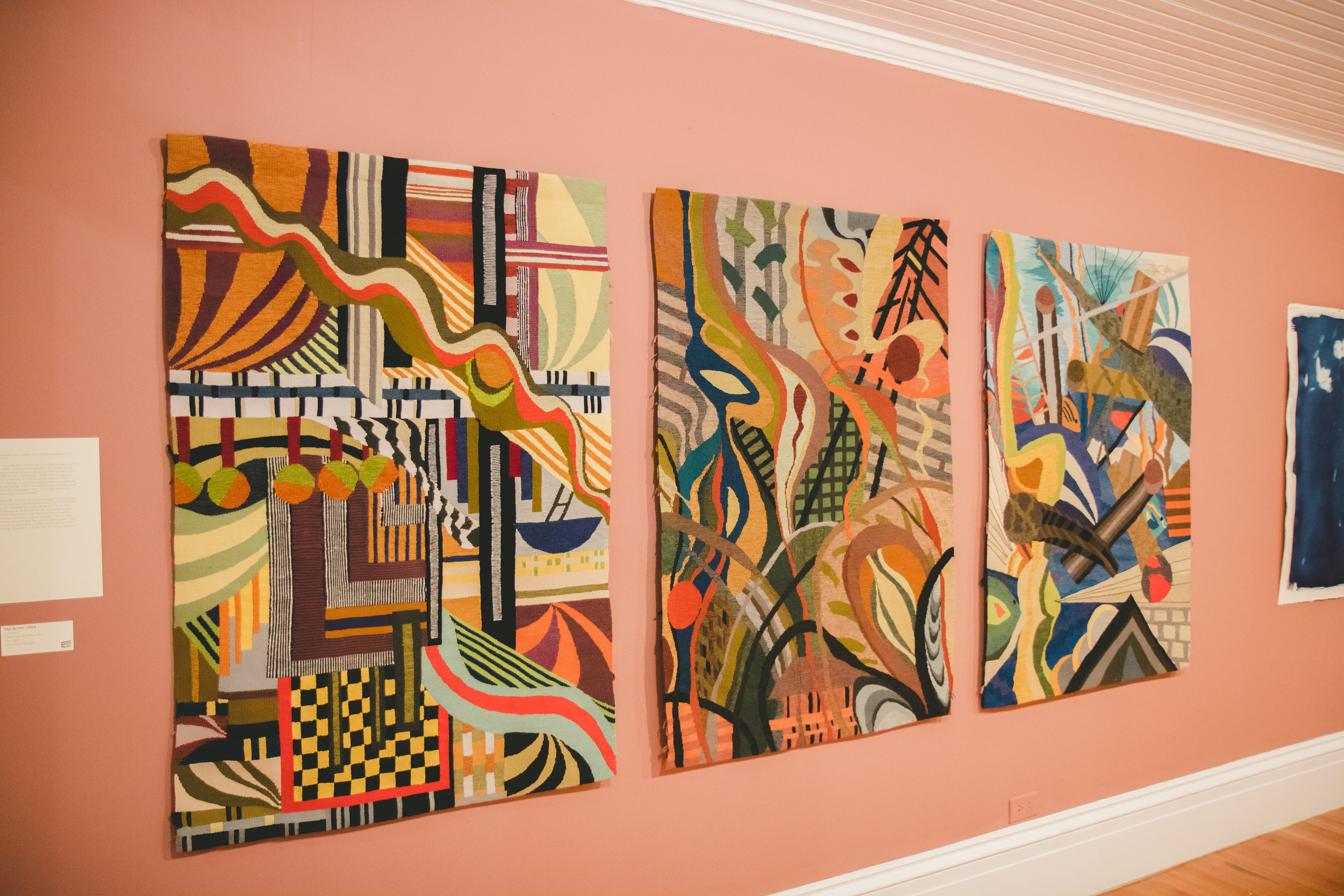
By Dr Ian Bethell-Bennett
The University of The Bahamas
Feminist ecology and ecocriticism have usually pushed for embracing the environment and awareness of the same in our life ways. The intersection of art, ecology and a female’s perspective is often fertile space for serious discussions and new understandings of society, and its socioeconomic and sociopolitical challenges.
The environment and ecology are under serious threat as we can see from Naomi Klein’s This changes everything: Capitalism vs the Climate (2014) along with the U.S. government’s recent report on the dangers of climate change as well as the United Nations’ Report on Climate change. Capitalism, usually seen as the driver of economies and the joy of consumption, encourage a particular disregard for conservation and natural balance in favour of expansive and unlimited profits.
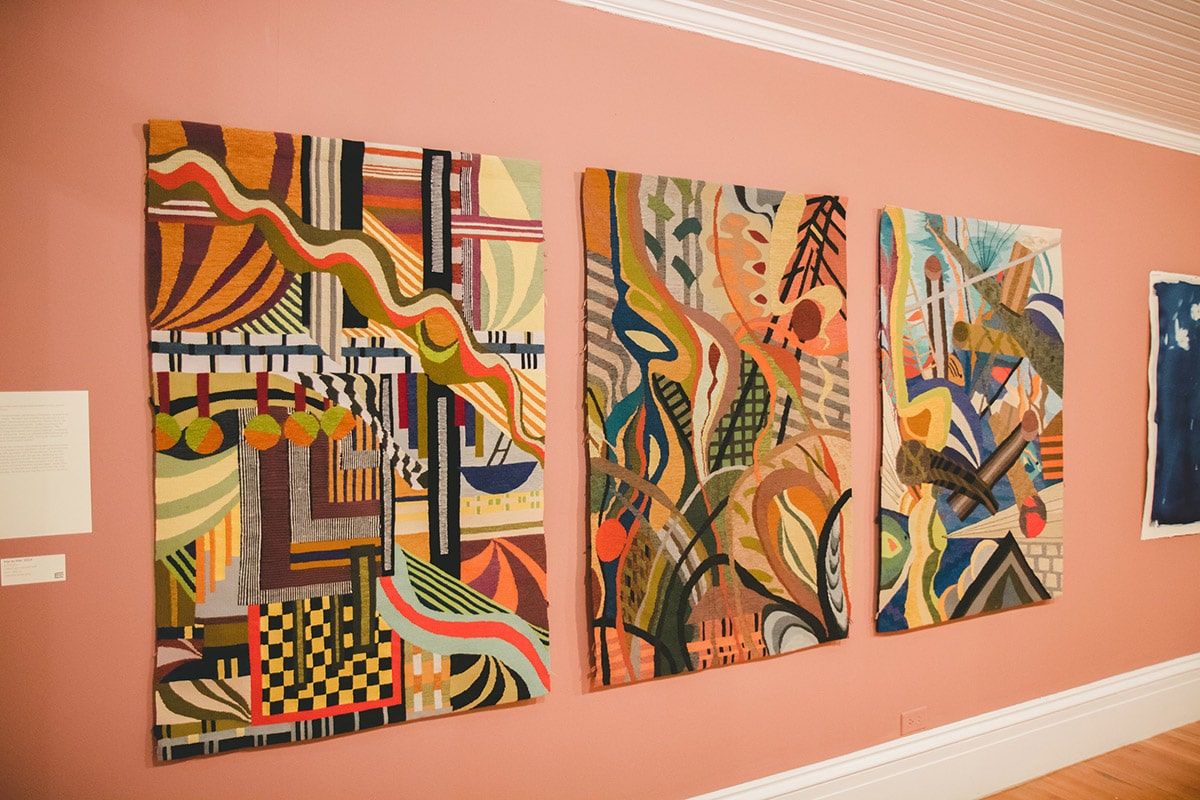
Tapestries by Jo Morasco as part of the NE9.
Meanwhile, artists, nature lovers and regular citizens face the threat of extinction through rising sea levels and increased storm frequency and ferocity due in large part to human consumption of fossil fuels and living outside of harmony. One of the links that we as island dwellers refuse to make is the link between the patriarchy and masculinist discourse that deny the existence of climate change and sea level rise. They reflect a deeply colonial mindset that negates the outward reality. They also offer the limitless life of market growth and profit. However, all things are limited, there is no unending elasticity to profits.
The Small Axe Project has recently focused a spotlight on climate change/environment in the Caribbean with an evening at NYU “Eye of the Storm: A Conversation on Capitalism, Colonialism, and Climate Change in the Caribbean” and were grappling with, “the ways in which neoliberal capitalism, colonialism, and climate change have come together in the Caribbean to reanimate and strengthen economic and racial hierarchies that have long marked the region and its place in the world”.[1]
These are points underscored by the works of Jo Morasco and Natascha Vazquez, who articulate through various artistic forms, the threat of capitalism on our ecologies/environment and lives. Yet many remain silent through consumption and state apparatus.
Morasco asks us to: “Speak out! Speak up! Be heard! Pick up! Clean up! Participate! Build responsibly and dispose respectfully”, while Vasquez notes:
“I have been collecting mangrove plants and roots that have been uprooted and destroyed to make way for new developments in New Providence. Upon witnessing these graveyards I develop a deep sadness, one that has inspired me to re-contextualize the way I see these plants dying. “
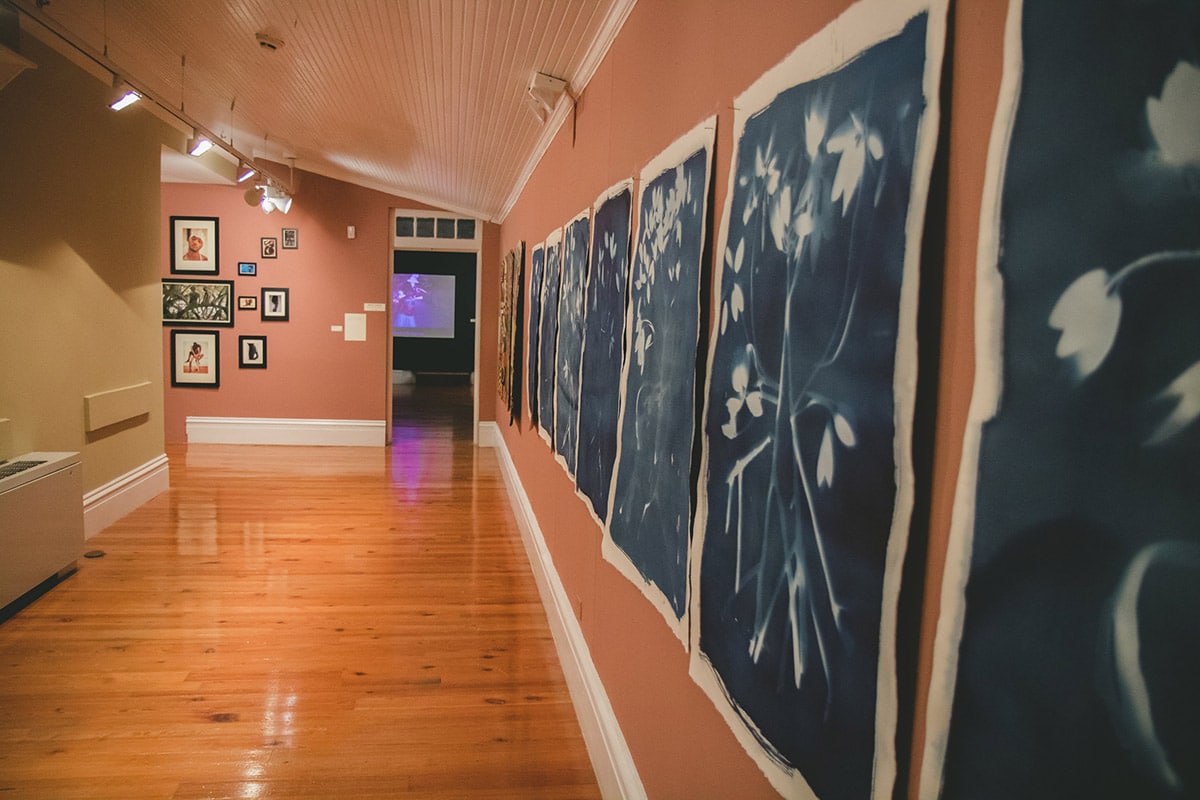
Works from the “Carbon Blue” series, (2018). Natascha Vasquez. Cyanotype on paper. 29 1/2″ x 41 1/2″. Work courtesy of the artist.
This is a part of the artist’s recognition of the fragility of ecology in the face of capitalist expansionism. As Klein notes, capitalism versus the environment is a dystopic space to inhabit. As low-lying SIDS, Bahamian political agenda has maintained a non-proactive position on improving the environment to better support us. The artists’ critique of this inertia is strong and beautifully crafted so that our risks and losses are clear. At the same time, nothing national is being done to overtake the capitalist discourse.
The Ninth National Exhibition NE9, gives space to those who manifest about the country’s vulnerable geography by showing the realities of climate change, unsustainable development practices and their fall out. Vazquez works with mangroves, as she says, a vulnerable commodity as new developments take over and root out or deracinate evidence of mangroves in efforts to expand profit. Morasco equally understands through her textile work Mal de Mar (2017) that Bahamian ecology suffers through poor and masculinist development deals that propose to surrender environment for profit. Island sales along with continued use of known pollutant, exhaustible fossil fuels leave our low-lying, small-island, developing state under threat. Morasco’s work explores this environmental degradation through the beguiling calm of tapestry, the everyday beauty of living art to bring to the fore the choices we take when we opt to bias our focus exclusively towards industrialisation and it contamination, which is easily attenuated based on simple more positive choices. Her description is interestingly provocative:
“A tapestry is generally an object of domestic calm, but the unsettling imagery in this piece is intended to show the conflict between our sacred environment and the secular stresses of industrialization.”
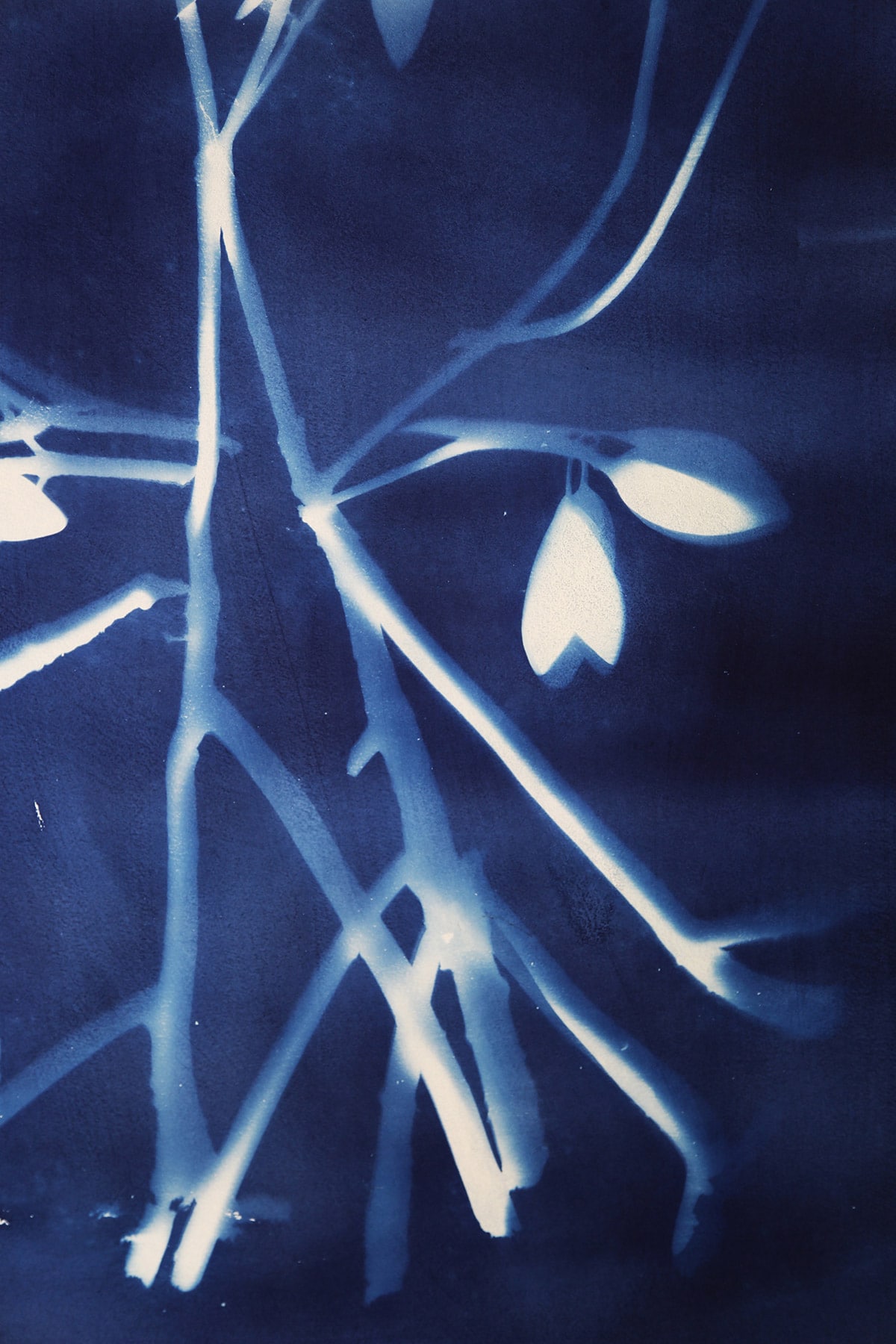
Works from the “Carbon Blue” series, (2018). Natascha Vasquez. Cyanotype on paper. 29 1/2″ x 41 1/2″. Work courtesy of the artist.
The conversation between Vazquez’s work and Morasco’s work is revelatory. They use distinct approaches to environmental issues, as Marosco’s tapestry Mal de Mar (2017) ” addresses the ill human being inflict on the seas. These feminist ecocritical moments, show links between over-development, coloniality and dis-harmony. Vazquez uses dark blue ink and mangroves to illustrate the strength and stability of these in their natural environment: areas which are naturally resilient and self-regenerating, except that, as masculinist paternalistic colonial harm and ownership impose a structure of domination over the environment, we disable the strength of nature to regenerate. In The Bahamas, attested by these works, the juxtaposing yet harmful dis-harmony between industry and nature, man and the environment can be seen as deep coloniality as patterns of settlement and exploitation resurface to excavate the nature from coasts. So, while the seas are known to provide passage and sustenance, they are also savage and brutal as they send storm surges and tsunami waves into communities. The focus of Vazquez’s ink protects the coast from these swells, yet as we build out less sustainable and more invasive homes for new kinds of developments, the feminine land is destroyed and the balance between protective mangroves and harmful oceans is highlighted. Poisoned waters flood lands and take lives.
Industry, as seen in 19th-century England can choke off life from the environment. These aspects of the balance between nature and industrialisation were explored from the Naturalists to the Romantics who saw a return to nature as being an answer. Today, we understand that ecofeminism provides some serious insight into the crisis of balance and earthly harmony. These works are beautiful in their unimposing textures; they are resoundingly successful in grappling with the complexity of equitable relations.
Both works pay keen attention to colour and contrast. The conflicting of light and dark is important to communicating the transformation and transitions in work. The calm, reflective nature of the pieces allows for reflection and introspection of the viewer. The language and feel of the pieces is arresting but also soothing. Mal de Mar (2017) It arrests because it is chaos of colonialist domination that brings to mind the language of government that promises to be proactive and ends up being regressive. The challenge is to circumvent or decolonise governance and its structures, as much feminist ecocritcism and decolonial readings and interrogations reveal.
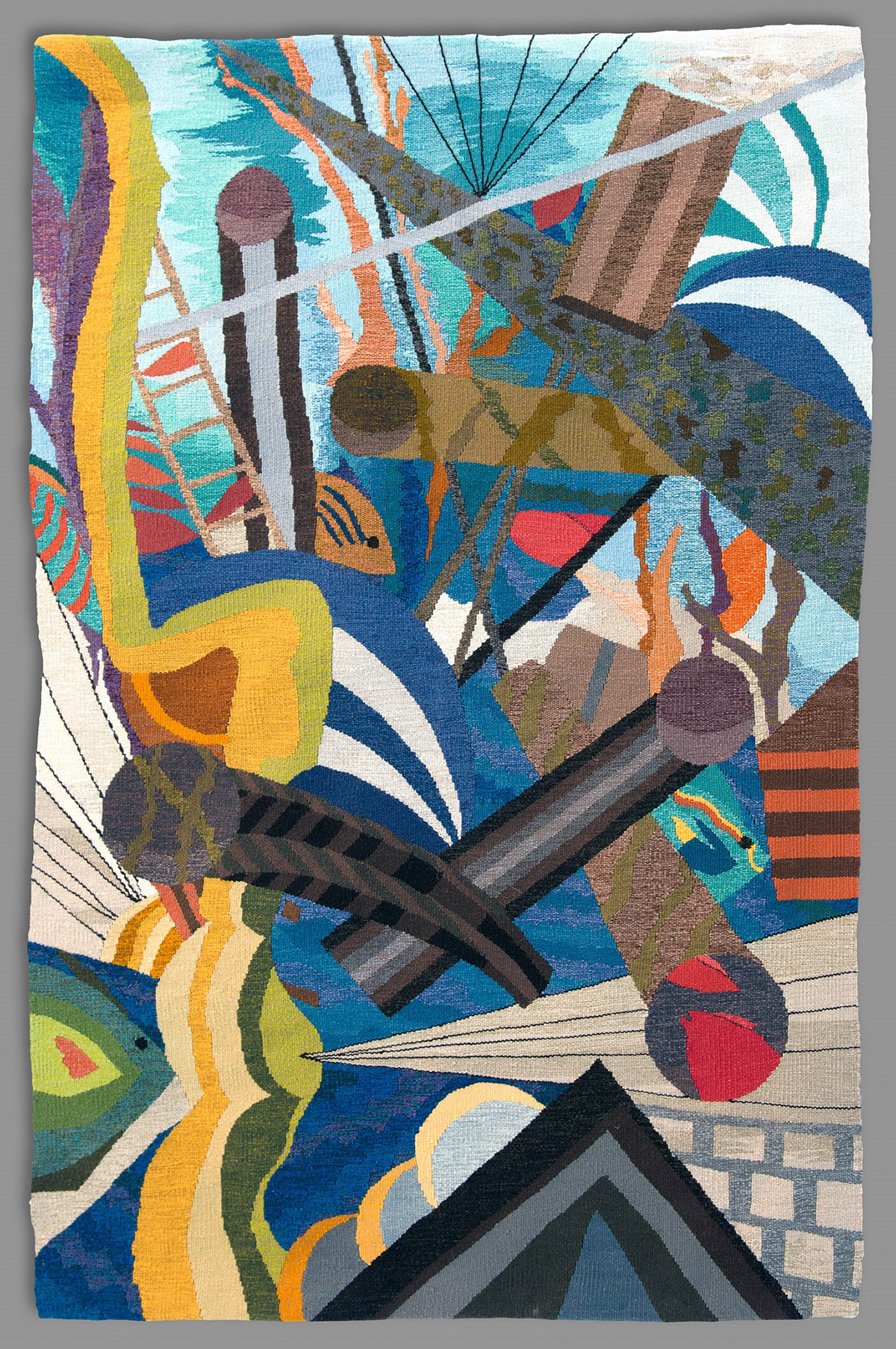
Mal de Mer, (2016). Jo Morasco. Cotton warp, wool weft. 34 ½” x 51 ½”. Work courtesy of the artist.
Through this vibrant work hosted in the NE9 “The Fruit and The Seed” seem to be well served as both artists stretch the collective unconscious and the group conversation in ways that seep in without obtruding. As island dwellers these works should give us pause, as the spaces shrink and the hills disappear under the teeth of bulldozers, the sea, with which we must poetically relate, as Hemmingway’s The Old Man and the Sea (1952). The new iteration of patriarchal power as seen in the domination articulated through and by the President of the United States and The Bahamas government causes (dis)ease when counterpointed by the reality of small islands with coastlines denuded of mangroves. The sacred is rapidly being sacrificed to last year’s deficit of poor planning and mismanagement that ignores the reality and relevance of shifting tides, rising winds and heat and feels-like temperatures that go beyond what we have known for generations. These artists speak to the universality of delicate geographies and the specificity of Bahamian ecological devastation; the need for revisioning our presents.
[1] http://smallaxe.net/sxlive/eye-storm-conversation-capitalism-colonialism-and-climate-change-caribbean accessed on Jan 4th, 2019